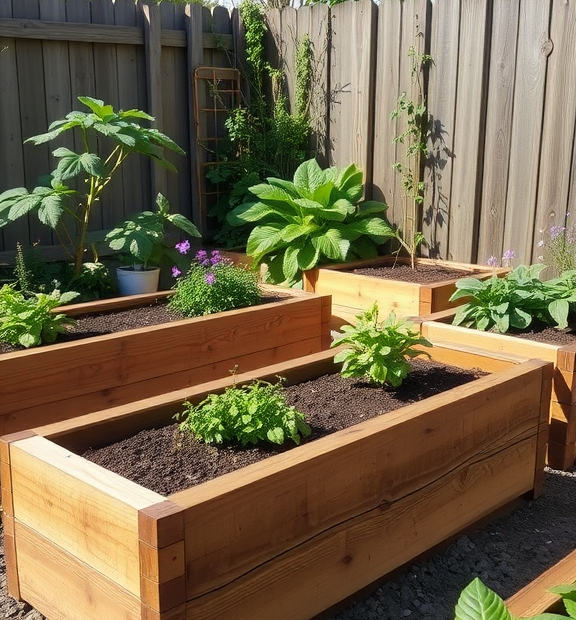Benefits of Raised Garden Beds DIY for Home Gardening
Raised garden beds DIY offers a fantastic way to enhance your gardening experience. If you’ve ever thought about growing your own vegetables, herbs, or flowers, building your own raised garden beds can open up a world of benefits. Not only do these beds make gardening more enjoyable, but they also provide a practical solution for many common gardening challenges.
Improved Soil Quality
One significant advantage of raised garden beds is the control you have over the soil quality. You can create the perfect mix of compost, soil, and nutrients tailored to the needs of your plants. This customization leads to healthier plants and better yields. The raised structure keeps the soil well-drained, reducing the risk of root rot and other common issues associated with poor drainage.
Ease of Access
Gardening can sometimes be physically demanding, especially for individuals with mobility issues or those who simply prefer an easier approach. Raised beds relieve some of this strain. Because they elevate the planting area, you won’t need to bend down as much, making it easier to tend to your plants. This reduces back pain and makes gardening a more enjoyable activity overall.
Better Pest Control
Pests can ruin your garden, but raised garden beds can act as a barrier. By elevating the plants, you can more easily prevent pests from accessing the garden. Additionally, you can implement simple protective measures, like row covers or nets, to keep insects at bay. These strategies can lead to healthier plants and less need for chemical pesticides.
Extended Growing Season
Raised beds warm up quicker in the spring than ground-level gardens. This is because the soil in a raised bed gets more sunlight and is less affected by cold ground temperatures. As a result, you can start planting earlier in the season. You can also extend your gardening season into the fall by using row covers to protect plants from early frosts. This means you can enjoy fresh produce for a longer time.
Minimized Soil Compaction
Soil compaction can be a nightmare for gardeners. When soil is compacted, it becomes hard, making it difficult for plants to grow. With raised garden beds, you can prevent soil compression since you don’t step on the soil in the planting area. This helps maintain loose, aerated soil, allowing roots to expand deeply and absorb nutrients effectively.
Accessibility to Beginners
If you’re new to gardening, raised beds can simplify the process. They create defined spaces for plants and are more manageable, especially for a novice gardener. You can easily plan out your layout, which reduces the chances of overcrowding or planting incompatible plants together. Plus, the clear borders guide you as you work in the garden.
Organizational Benefits
Love what I do? Be a hero and help me keep creating awesome content!
Support My Mission Now!Every donation fuels more great stuff – thank you, legend!
Raised garden beds can provide some organizational advantages. You can create pathways between your garden beds for easy access, ensuring that your plants have enough space to grow without hindrance. This structure can help you keep track of what you’ve planted in each bed, making it easier to rotate crops and manage your garden effectively.
Aesthetically Pleasing
Beyond practicality, raised garden beds can enhance the beauty of your outdoor space. They add a structured look to your garden while providing a clear border for various plants. You can choose materials like wood, stone, or metal to match your landscape design, giving personality and charm to your backyard. A well-planned raised bed garden can become a focal point that you, your family, and guests will appreciate.
Cost-Efficiency
Love what I do? Be a hero and help me keep creating awesome content!
Support My Mission Now!Every donation fuels more great stuff – thank you, legend!
Building your own raised garden beds can be a cost-effective solution for home gardening. You can source materials such as reclaimed wood, bricks, or even cinder blocks to keep expenses low. Additionally, growing your own food can save you money on grocery bills, especially for organic produce, which can often be expensive.
Raised garden beds DIY provide an array of benefits that cater to both seasoned gardeners and beginners. With improved soil quality, ease of access, better pest control, and cost savings, you significantly enhance the gardening experience. Building your own raised beds is a fulfilling project that can lead to abundant harvests while beautifying your outdoor space. Make gardening accessible and enjoyable by investing some time in a DIY raised garden bed today!
Step-by-Step Guide to Building Your Own Raised Garden Beds
Building raised garden beds is a fantastic way to create a productive and beautiful garden. Not only do they increase drainage and soil quality, but they also make gardening easier on your back. If you’ve decided to take the plunge into the world of raised garden beds DIY, here’s a step-by-step guide to get you started.
Materials You Will Need
- Wooden planks (cedar or redwood are great choices)
- Wood screws or nails
- Power drill or hammer
- Saw (hand saw or circular saw)
- Measuring tape
- Level
- Landscape fabric (optional)
- Soil and compost
- Plants or seeds for your garden
Step 1: Choose the Right Location
Love what I do? Be a hero and help me keep creating awesome content!
Support My Mission Now!Every donation fuels more great stuff – thank you, legend!
Finding the right spot for your raised garden bed is crucial. Look for a location that gets plenty of sunlight, ideally at least six hours a day. Ensure the area has good drainage to prevent water from accumulating around your plants. Avoid areas with overhanging trees, as falling leaves can create a mess.
Step 2: Determine the Size and Shape
Your raised garden bed can be any shape and size. However, a common size is 4 feet wide by 8 feet long, allowing easy access from all sides. The depth should be at least 12 inches to accommodate most vegetables. Marking the area with stakes and string before you start building can help visualize the size.
Step 3: Gather and Prepare Materials
Love what I do? Be a hero and help me keep creating awesome content!
Support My Mission Now!Every donation fuels more great stuff – thank you, legend!
Now that you have your dimensions set, gather the materials. Choose untreated wood to avoid chemical leaching into your soil. If you prefer a more aesthetic look, consider using stone or brick. Ensure you cut your wooden planks to the correct lengths as per your design.
Step 4: Assemble the Raised Garden Bed
Begin by laying out the cut wood in the shape of your garden bed. Use wood screws or nails to secure them at the corners, creating a sturdy rectangular frame. Check that the corners are square by measuring diagonal lengths. Use a level to ensure the sides are even. If you want extra durability, consider adding corner brackets for support.
Step 5: Position the Bed
Carefully move the assembled bed to the chosen location. If necessary, remove sod or grass from the area where the garden bed will sit. This will help prevent weeds from growing inside your raised bed. You may choose to place landscape fabric on the ground before positioning the bed to create a barrier against weeds.
Step 6: Fill with Soil
Now it’s time to fill your raised garden bed with soil. A mix of topsoil, compost, and aged manure works best for a nutrient-rich environment. Fill it to the top, making sure to level it off. This mixture will help your plants thrive as they establish their roots in these nutrient-rich soils.
Step 7: Plant Your Garden
With your garden bed filled, it’s time to plant! Consider what plants you want and whether they thrive in full sun or partial shade. Be sure to follow recommended spacing guidelines for each type of plant. You can plant seeds directly or transplants, depending on your preference.
Step 8: Care for Your Garden
After planting, water your garden regularly, especially during dry spells. Keep an eye out for pests and diseases as your plants grow. Mulching around your plants can help retain moisture and control weeds. As your plants start to flourish, enjoy the fruits of your labor!
Building raised garden beds DIY is not just an enjoyable project but also a beneficial way to grow your own food. With a little effort and attention, you will create a beautiful garden that provides for you and your family. Happy gardening!
Conclusion
Creating your own raised garden beds DIY not only enhances the beauty of your home but also offers a wealth of benefits that can transform your gardening experience. By building raised garden beds, you can effectively manage soil quality, improve drainage, and reduce the risk of pests and weeds. This makes it easier for you to cultivate a lush and productive garden, even in limited space.
The step-by-step guide provided outlines a straightforward approach to constructing your raised beds. From selecting the right materials to planning your layout and assembling the structure, each phase helps you develop a personalized garden that fits your needs. With a little time and effort, you can achieve a functional and aesthetically pleasing setup that encourages growth.
Love what I do? Be a hero and help me keep creating awesome content!
Support My Mission Now!Every donation fuels more great stuff – thank you, legend!
Moreover, DIY raised garden beds empower you to engage with nature and provide fresh produce for your family. This hands-on project not only enriches your gardening skills but also offers a rewarding sense of accomplishment as you watch your plants thrive. Plus, the experience of nurturing your garden can foster a deeper appreciation for the environment.
As you embark on this journey, remember that each garden is unique, just like your preferences. Personalize your raised garden beds with your chosen aesthetics, plants, and colors. Whether you’re a novice gardener or a seasoned expert, the joy of gardening in raised beds can elevate your home and your lifestyle. Since gardening is a journey, take the time to enjoy every step, and soon enough, you’ll be reaping the benefits of your labor in delicious, homegrown harvests.

